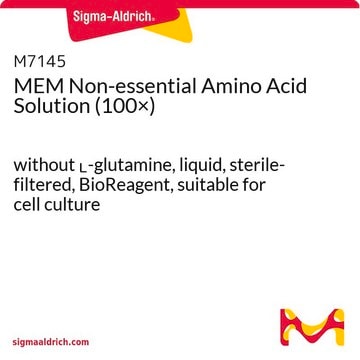If this product has an expiration or retest date, it will be shown on the Certificate of Analysis (COA, CofA). If there is no retest or expiration date listed on the product's COA, we do not have suitable stability data to determine a shelf life. For these products, the only date on the COA will be the release date; a retest, expiration, or use-by-date will not be displayed.
For all products, we recommend handling per defined conditions as printed in our product literature and website product descriptions. We recommend that products should be routinely inspected by customers to ensure they perform as expected.
For products without retest or expiration dates, our standard warranty of 1 year from the date of shipment is applicable.
For more information, please refer to the Product Dating Information document: https://www.sigmaaldrich.com/deepweb/assets/sigmaaldrich/marketing/global/documents/449/386/product-dating-information-mk.pdf
H0887
HEPES solution
1M, liquid, pH 7.0-7.6, suitable for cell culture, BioXtra, BioReagent
Synonym(s):
N-(2-Hydroxyethyl)piperazine-N′-(2-ethanesulfonic acid)
About This Item
Recommended Products
Product Name
HEPES solution, 1 M, pH 7.0-7.6, sterile-filtered, BioReagent, suitable for cell culture
sterility
sterile-filtered
Quality Level
product line
BioReagent
BioXtra
Assay
0.9—1.1 M
form
liquid
storage condition
(Tightly closed. Dry)
dry at room temperature
concentration
1 M
technique(s)
cell culture | mammalian: suitable
impurities
endotoxin, tested
color
colorless
pH
7.0-7.6
useful pH range
6.8-8.2
7.5
density
1.1 g/cm3
suitability
suitable for component for culture media
suitable for electrophoresis
application(s)
cell analysis
life science and biopharma
sample preparation
storage temp.
2-8°C
SMILES string
OCCN1CCN(CCS(=O)(O)=O)CC1
InChI
1S/C8H18N2O4S/c11-7-5-9-1-3-10(4-2-9)6-8-15(12,13)14/h11H,1-8H2,(H,12,13,14)
InChI key
JKMHFZQWWAIEOD-UHFFFAOYSA-N
Looking for similar products? Visit Product Comparison Guide
General description
Furthermore, it surpasses bicarbonate buffers (NaHCO3) in its ability to maintain physiological pH despite fluctuations in carbon dioxide concentration arising from cellular respiration, a key factor in maintaining cellular homeostasis. Beyond its exceptional performance in cell culture, HEPES may also find application in various biological and biochemical studies. It may also be valuable in techniques like immunoprecipitation, cell lysis, and live cell imaging, providing a stable and controlled environment for experimental procedures. The combination of its versatility, exceptional pH buffering capacity, and minimal interaction with other molecules positions HEPES as an indispensable tool across diverse research fields.
Application
- Hank’s balanced salt solution, Dulbecco’s modified eagle’s medium and no-glucose DMEM, which are used for the preparation of tissue slices[2][3]
- Buffers used in localized conductance measurements on the basolateral side of culture inserts to examine cation selectivity[3]
- cell culture media to provide buffer capacity to maintain the pH of the cell line[4]
- buffer in decellularization of porcine nucleus pulposus[5]
Features and Benefits
- High purity product for biochemical and biological research
- Sterile filtered and cell culture tested
- Ready Solution reduces the need
- Useful for the pH range of 6.8 - 8.2 and pKa of 7.5 at 25 °C
- Ready available solution reduce the need for preparation time
Caution
Preparation Note
Other Notes
comparable product
related product
Storage Class Code
10 - Combustible liquids
WGK
WGK 1
Flash Point(F)
Not applicable
Flash Point(C)
Not applicable
Choose from one of the most recent versions:
Already Own This Product?
Find documentation for the products that you have recently purchased in the Document Library.
Customers Also Viewed
Protocols
Discover our primary human hepatocytes and plating and maintenance media formulations. Explore our protocol for plateable primary hepatocyte cell culture.
Discover our primary human hepatocytes and plating and maintenance media formulations. Explore our protocol for plateable primary hepatocyte cell culture.
Discover our primary human hepatocytes and plating and maintenance media formulations. Explore our protocol for plateable primary hepatocyte cell culture.
Discover our primary human hepatocytes and plating and maintenance media formulations. Explore our protocol for plateable primary hepatocyte cell culture.
Related Content
Explore our protocol for suspension primary hepatocyte cell culture. Discover our primary human hepatocytes and plating and maintenance media formulations.
Explore our protocol for suspension primary hepatocyte cell culture. Discover our primary human hepatocytes and plating and maintenance media formulations.
-
How can I determine the shelf life / expiration / retest date of this product?
1 answer-
Helpful?
-
-
How is shipping temperature determined? And how is it related to the product storage temperature?
1 answer-
Products may be shipped at a different temperature than the recommended long-term storage temperature. If the product quality is sensitive to short-term exposure to conditions other than the recommended long-term storage, it will be shipped on wet or dry-ice. If the product quality is NOT affected by short-term exposure to conditions other than the recommended long-term storage, it will be shipped at ambient temperature. As shipping routes are configured for minimum transit times, shipping at ambient temperature helps control shipping costs for our customers. For more information, please refer to the Storage and Transport Conditions document: https://www.sigmaaldrich.com/deepweb/assets/sigmaaldrich/marketing/global/documents/316/622/storage-transport-conditions-mk.pdf
Helpful?
-
-
Bonjour, Est-ce que ce produit H0887 peut-être congelé à -80°C sans risque de le faire précipiter ?
1 answer-
It is best not to freeze the product as received. However, should the product be inadvertently frozen, it is best to thaw the product slowly. Do not place the frozen product in an incubator or water bath. Once thawed, inspect for any precipitates before use. A clear, colorless solution will be suitable for further use. Should this buffer be required to prepare the stock solution of another reagent that requires freezer storage, thaw slowly if possible.
Helpful?
-
Active Filters
Our team of scientists has experience in all areas of research including Life Science, Material Science, Chemical Synthesis, Chromatography, Analytical and many others.
Contact Technical Service






